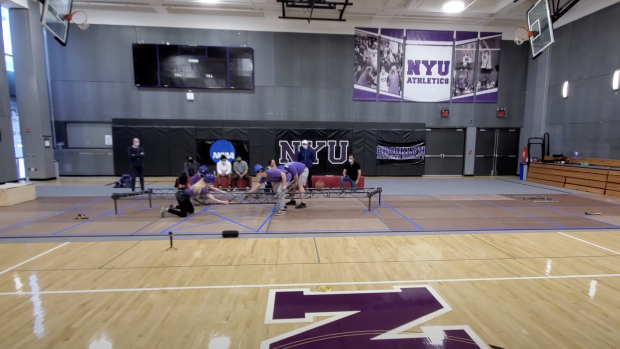NYU Tandon Steel Bridge team displays nerves of steel on way to nationals

Year after year, NYU Tandon’s Steel Bridge team strives hard at the American Institute of Steel Construction (AISC) Student Steel Bridge Competition. This year, however, hopes were not running high. The organization had decreed that because of the COVID-19 crisis, teams would have the option of working fully remotely — submitting just a design report and presentation but not actually building a bridge — or building their bridge on their individual campuses, rather than at a festive central event with teams from across the country.
That in itself might have been disappointing enough, but when the organization added major rule changes, the situation became even more fraught.
“Generally, the bridges are judged on the basis of how easy they are to build, how light they are, and how stiff they can remain when bearing a load,” professor and alum Mark Milkis, who advises the team, explained. “This year, because the judges were not going to be on-site, it would have been impossible for them to accurately measure stiffness, so that factor was eliminated.”
The Tandon design — which was being repurposed from last year’s cancelled competition, as per AISC guidelines — had, however, been optimized with stiffness in mind. In late March, at the regionals, the team had fared well enough, coming in second, but members wondered how they would fare at the more hotly contested nationals.
With just a month to prepare, reworking their design would be an ambitious undertaking, but no one has ever accused Tandon students of lacking in ambition.
“We knew we needed to optimize for lightness,” team captain Inez Warshaw recalled. “So, we immediately got rid of half the bridge; in all we removed 26 pieces and updated a few more, cannibalizing old bridges for parts when we had to, because there was no time to fabricate new ones.”
Their design — the first Tandon steel bridge in several years to eliminate a superstructure — went from 300 pounds to well under 200, but questions remained: how much of a load would it bear? How well would it hold up?
The answer was well enough for a sixth-place finish in a crowded field of teams whose designs had not been as severely affected by the rule changes.
“There are many civil-engineering challenges out in the real world, and they have to be addressed with the highest standards of professionalism, creativity, and technical skill,” said Chair of the Department of Civil and Urban Engineering Magued Iskander, “I think our students have proven here that they will be up for whatever comes their way.”
You can watch various steel bridge “Compete from Campus” events on the NYU Steel Bridge YouTube channel.


